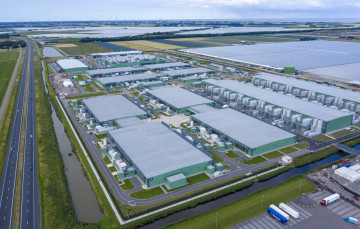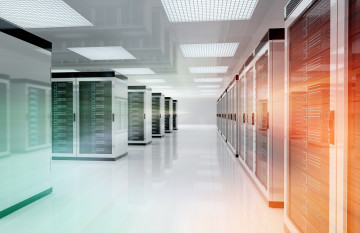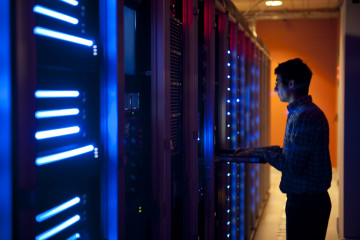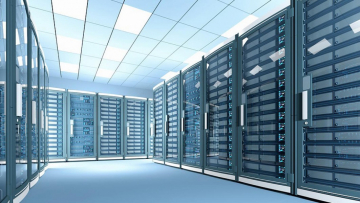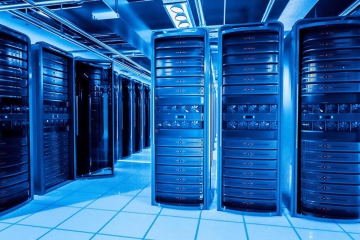It is well-known and accepted that data centers are growing and expanding at a fast rate. With this growth, the exposure to risks and hazards will continue to increase. However, unlike the number of data centers popping up, the hazard risks can be anticipated and controlled with proper identification, evaluation, and preparation.
Some data center clients and providers are getting ahead of the game for their site hazards and protecting employees by taking a proactive approach through their audits and assessments. Fortunately, these hazards are present throughout other industries and are not new in terms of hazard type. This can be a great way to apply best management practices that are already used in other industries to data centers.
Top 5 Health and Safety Findings
Antea Group has been conducting health and safety audits at data centers for years. Below, we have consolidated and analyzed the information obtained from decades of audits and assessments of operational data centers to identify the top five most common health and safety findings. We have also included examples of international regulations to demonstrate the complexities of EHS compliance in data centers.
For a look at our top 5 Environmental Findings from data centers, check out this blog post.
1. Noise Assessment
Servers and fan ventilation systems are the main sources of environmental noise within data halls. These systems can vary between each data center based upon the size of installed servers, the make and model of servers operating, and the ventilation system to keep the servers cooled within the hot aisles.
Due to this continuous and intermittent fan noise within the data halls, the sound pressure levels can rise above an 85-decibel level on an a-weighted scale (dBA). Noise exposure at or above this level for an 8-hour shift is considered hazardous. Other factors to consider when evaluating noise exposure is time spent within the data center and distance an employee works relative to the servers.
In most cases, data centers haven’t completed a baseline noise assessment that includes either personal dosimetry (if regulation requires) or sound level measurements. This baseline assessment is key to determining whether any programmatic or occupational measures need to be in place.
International Regulation Example:
In the United Kingdom, companies must follow the Control of Noise at Work Regulations 2005 (The Regulations), which is based on a European Directive requiring similar basic laws throughout the Union on protecting workers from the risks caused by noise. The duties of The Regulations are in addition to the general duties set out in the European Directive. These general duties safeguard the health and safety of people, and that extends to those who are not your employees, such as students, voluntary workers, visitors, and members of the public.
Regulation 5 of the Regulations provides specific advice to the employer about risks created by exposure to noise in the workplace. It states: An employer who carries out work which is liable to expose any employees to noise at or above a lower exposure action value shall make a suitable and sufficient assessment of the risk from that noise to the health and safety of those employees and the risk assessment shall identify the measures which need to be taken to meet the requirements of these regulations.”
2. Heat Stress
Data halls are known for having a cooling system, which is necessary for keeping servers at an optimal temperature. With this operational necessity also comes the risk of heat exposure for workers within the hot aisles. Determining the risk of heat stress as an occupational hazard depends on multiple factors such as workload or metabolic activity, acclimatization, clothing, wet bulb globe temperature, and more. Due to all these varying factors, the best way to determine risk is through a heat stress assessment.
In many cases, data centers have yet to assess their data hall environments for heat stress risk and therefore don’t know what controls to implement. In the United States, OSHA provides guidance for this. Plus, some states like California and Minnesota also have regulations related to indoor heat stress that should be tracked for impacts to businesses. Due to varying regulations globally, having a qualitative assessment done would provide the best guidance to determine how to tackle this hazard.
International Regulation Example:
In Singapore, the occupier of a workplace must take measures to ensure that employees and/or contractors are protected from excessive heat or cold and harmful radiations in the workplace (Workplace Safety and Health (General Provisions) Regulation, Section 10). Data centers need to be kept cool to remain functional, which can be very challenging in tropical climates. Thus, it is important to have a plan to map heat within your data center. Plus, during hotter days when the data center struggles to reduce indoor temperature, taking breaks and raising awareness of the risk to employees is key. There has also been a market movement to use technology to track temperatures for energy efficiency as well as employee protection.
3. Electrical Safety
Many electrical hazards exist within the data center environment from power generation to server backup power. These can vary from high voltages to low, and they can present the possibility of severe injuries. In most cases, injuries come when qualified contractors conduct work on major electrical changes. Ensuring contractors perform work safely in and around the electrical environment is critical to prevent serious injury. For the general worker within the data hall, it’s important to teach them electrical awareness for working in spaces with electrical hazards. It’s also crucial to ensure workers’ tools are appropriate for this type of environment. This may include a hazard assessment to determine the use of intrinsically safe tools, ladders, and more.
International Regulation Examples:
In Austria, companies must follow the Federal law named the Health and Safety at Work Act. It states that in any workplace where employees work on electrical installations, employers must ensure that the proper work equipment and items of personal protective equipment are present. It also states that employers must ensure that any facilities used for fire detection or firefighting, first aid, and rescue from danger are properly maintained.
While this is just one example of many, the regulation citation may be different in every country. In most cases the employer is required to complete a risk assessment, provide and train employees on the use of personal protective equipment (PPE), and use specialized training. This is uniform across the globe.
4. Ergonomics
Most people associate computer troubleshooting with plugging in cables and cords, however, within the data center environment, workers are conducting server change outs and replacements as a regular part of the job. This should not be taken lightly, as servers can weigh around 35 pounds or more. This load weight combined with the awkward size and potential lifting repetition can all ‘weigh’ in ergonomic hazard risks and potential for injury. In these cases, data center work should be evaluated for these types of risks and mitigation measures.
International Regulation Examples:
While ergonomic regulations vary across the globe, most countries offer some guidance for how employers should protect workers from ergonomic risks. One example comes from South Africa, which has the Occupational Health and Safety Act 85 of 1993 and the Ergonomics Regulations of 2019. In this regulation, the employer must, before the commencement of any work, have an ergonomic risk assessment performed by a competent person. This document should be reviewed whenever there is a change and at least every 2 years.
Other countries have similar but slightly varying regulations, and many also require employers to complete an ergonomic assessment like South Africa.
5. Lone Working
In data centers, lone work is becoming more common as facilities operate with fewer employees. A lone worker is a person who is performing their job alone, with no supervision or partner to help. Lone work also includes situations where several people are in the same building but are out of hearing range and/or out of sight from one another.
Although some regions and local regulations do not have specific lone working requirements, the risk is still present and can fall under other safety and health measures, such as how to follow an emergency action plan. Data centers should develop a plan for lone working and focus on protecting those workers within the data halls that do not have any other oversight. This is another piece to a data center’s health and safety program.
International Regulation Examples:
In France, the employer and the facility owner must review operations to identify any operations that require an employee to work alone. They must have protective measures established as required by the risk assessment Article L4121-3 of the Labor Code. This includes the requirement to train personnel to recognize unsafe conditions (isolation, poor lighting, unlit parking areas, unsafe building, etc.) and to know protective measures to take (e.g., maintain routine contact with coworkers, supervisors, managers, etc.) (Article L4121-1 of the Labor Code). This ensures that in any situation where an employer may not be aware of the danger that workers are exposed to, it is up to the employee to bring this danger to the attention of their superior. Once informed, the employer is required to take all necessary measures to put an end to the danger in question.
Other countries have their own lone work requirements that vary slightly. In general, having a corporate global policy and a communication standard in data centers ensures employees’ safety throughout the facility. As a founder of the global Inogen Alliance, Antea Group provides global coverage with local experts through our 75 Associate companies, giving us first-hand local regulatory and cultural nuance understanding with our multinational client needs.
Why Data Center Safety is More Important than Ever
Recognizing potential health and safety risks in data centers is crucial for keeping employees safe and maintaining compliance with regulations. Antea Group has assisted data centers and cloud data halls in many ways, including maintaining EHS regulatory compliance, providing support with internal and external auditing, developing safety and health programs, industrial hygiene sampling and analysis, and using management systems. Antea Group maintains a database documenting all state/provincial and local requirements, and we can apply this database to the data center health and safety environment.
For support in your data center, reach out to our Data Center Support service line, or our team of Health and Safety experts today.
Want more news and insights like this?
Sign up for our monthly e-newsletter, The New Leaf. Our goal is to keep you updated, educated, and even a bit entertained as it relates to all things EHS and sustainability.
Have any questions?
Contact us to discuss your environment, health, safety, and sustainability needs today.




